What Plant Is At The Center Of The Poison Garden
Hidden away in the Northumbrian countryside is a small but deadly garden and every plant inside it has the ability to kill you!
It's called the Alnwick Poison Garden and it's hidden away under strict lock and key, for obvious reasons.
However, if you're brave enough, you can cross the threshold and enter this potent plot to learn all about these intoxicating flowers and trees.
You may not know it but many of the most common plants you can find in your garden have poisonous properties that have the potential to be lethal.
Sure, it may be a little macabre but I can already tell this mysterious place has piqued your interest and imagination.
Here's a complete guide with some warnings for visiting the Alnwick Poison Garden. The deadliest garden in the world!
Disclaimer: My visit to the Alnwick Gardens was sponsored on my press trip with Visit Northumberland. Although I was a guest, all opinions are my own.

What is The Alnwick Garden?
The Percy family have lived in Alnwick Castle for the last 700 years. But, the history of The Alnwick Garden started in 1750 with the first duke of Northumberland.
He decided to lay down a planned garden on the estate with the help of Capability Brown, who was a famous Northumberland gardener at the time.
It was further expanded by the 3rd Duke of Northumberland who was an avid collector of plants. He sourced plant seeds from all over the world and even started to cultivate pineapples in a hothouse. Something that was a sign of status and wealth in that era!
The 4th duke created a conservatory in the 19th century and recreated the gardens in the Italian style as was the fashion.
During the Second World War, the Alnwick Gardens were repurposed to produce food for the public in the "Dig for Victory" campaign. Eventually, it fell into disrepair and was largely forgotten.
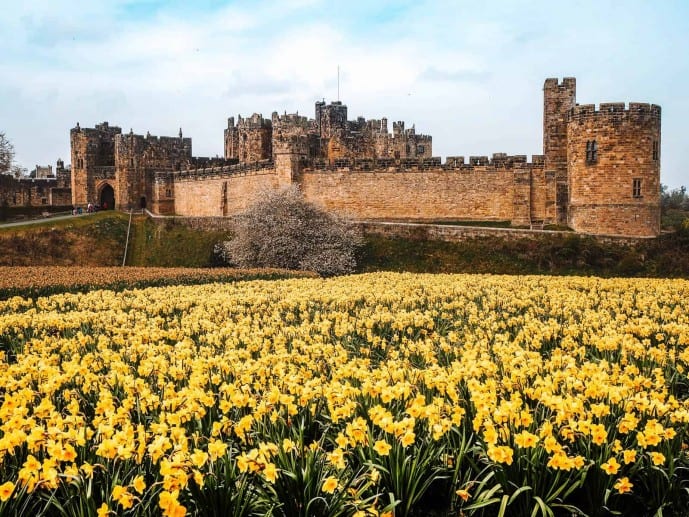
A gardens in renaissance
In 1995, following the death of his brother, Ralph Percy succeeded the Dukedom. He and Lady Jane became the 12th Duke and Duchess of Northumberland.
It wasn't expected and she felt largely unfulfilled with her ducal role. So, she was compelled to renovate The Alnwick Garden on the estate which fell into disrepair.
To help her with her ambitious vision, she hired the help of landscape artists Jacques and Peter Wirtz from Belgium. They worked at the Tuileries in Paris and even landscaped the French president's residence.
Together they carried out a huge renovation project at the cost of £42 million pounds.
Although the Duke and Duchess still contribute to the renovations, there have been a great number of challenges and so the gardens now belong to a charity trust.
Today, both Alnwick Castle and the gardens see well over 800,000 tourists visit each year. It's one of the most popular attractions in the North East of England!

Alnwick Poison Garden history
The poison garden we see today is an amazing achievement. A labyrinth of ivy-covered tunnels, witches huts, deadly night shade and even cannabis in cages!
However, the question remains; why is such a poisonous garden here in the middle of Northumberland?
Well, after a trip to Italy, the Duchess was inspired by one powerful family who used their gardens to kill their enemies.
The legendary Medici poison garden
The Medici family were one of the most influential and controversial families in the entire world.
They were largely responsible for the Italian Renaissance in Florence and had a swaying hand in Italian politics for well over 300 years.
The Medici's were originally a banking family who rose from obscurity to be the richest family in all of Italy and most of Europe. They were also a political dynasty and a royal house.
Being a powerful family like this comes with its fair share of enemies. But, this was easily managed.
The Medici's owned many villas across Padua with acres of landscaped gardens. A large area of these gardens was where they grew their poisonous plants.
They would use them to provide an effective arsenal with which to destroy their enemies!

Bringing the deadly idea to life
After visiting the Medici poison garden, the Duchess felt inspired. She knew she wanted an apothecary garden on the grounds to educate children on plant life.
But, she felt that just planting herbs that heal just wasn't enough. Children would lose interest very quickly.
But, creating a poison garden that educates on plants that can kill you?! Now, that would capture the imagination and attention of any age!
So, in 2005, she worked on gathering over 100 types of poisonous plants and trees to plant into the garden.
Ones that produce cyanide, can kill you instantly, are photo toxic and can even make you hallucinate.
It was a risky business to be sure, but her trusty team of gardeners were completely onboard.
Even now, they tend to these gardens in full hazmat suits, gloves and masks to make sure they don't inhale, ingest or touch any toxins which could be deadly!

Can you visit the Alnwick Poison Garden today?
YES, if you're feeling brave, the Alnwick Poison Garden is open throughout the year for visitors. It's a FREE tour that is included in your garden ticket.
It is locked away though and you are only allowed to enter the dangerous gardens on a guided tour. These run every 20-30 minutes throughout the day.
You can find out from the staff near the gate at what time the next one will be running. You don't need to book, just hover outside the gate before the tour is about to start!
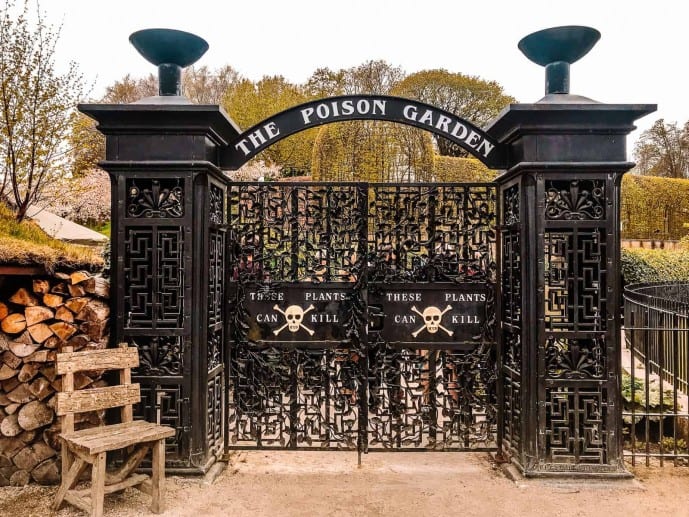
Is visiting the Alnwick Poison Garden safe?
If you follow the rules and don't touch, taste or smell anything too closely in the garden, then yes you'll be safe.
Your guide will give you warnings and strict rules before you enter the garden. If you are seen to be touching anything you'll be instantly removed.
Saying this, everyone is different and some people may be more sensitive to plant toxins than others.
People have been known to feel faint from just the smell of pungent toxins that are released from some of these plants in the air.
It is a little terrifying to be surrounded by so many potentially lethal things but other than that unease, you'll be completely fine.

Warnings for visiting the Alnwick Poison Garden
1. Tours are limited and are a first come first serve basis
Although there are plenty of tours for the Alnwick poison garden on a daily basis. These are on a limited first come first serve basis.
There are only 20-25 people allowed on the guided tour at a maximum for safety reasons.
To make sure that you get on a tour, I would definitely recommend that you arrive at the gate around ten minutes before the tour is about to start. The poison garden is one of the most popular attractions here and these do pack out really easily!
I got on the last tour of the day but it did mean waiting for a whole guided tour to finish. The tours last around 20-30 minutes.
While you're waiting, you can check out the witches hut that sits right outside the poison garden gate. It's a curious hut full of taxidermy crows, bottles and a log fire.

2.There are over 100 types of poisonous plants inside…
If you were wondering what plants are inside the Alnwick poison garden, there are over 100 deadly botanicals.
What you'll probably notice first is a lot of them are colourful and look similar to normal flowers. But, don't be fooled, they're pretty but deadly. You'll see Foxglove that can cause vomiting.
Monkshood, known also as Aconitum or Wolfsbane, that can kill you instantly. Daturas or Devils Trumpets will send you to sleep forever.
There are even Daffodils inside! Yep, those pretty daffodils in spring can cause poisoning too. If ingested, it could cause vomiting from stomach irritation.
As well as flowers, there are also trees, shrubs and vegetables that can be toxic. Some tree bark like Manchineel, if touched, can cause blindness.
Gorgeous British Yew Trees that have guided us for centuries are also extremely dangerous. Pretty much everything about it, if ingested, could be fatal.
Laurel, which is a common hedge filler can produce cyanide. Also, giant hogweed is phototoxic and can give you blisters and burns for up to seven years!
The red stems of Rhubarb are completely fine to eat, but did you know that their leaves are extremely toxic?!
In World War I, the home office recommended eating them due to ration supplies being low but when several people died they realised their mistake.
The list of complaints caused by touching, smelling or tasting these plants is honestly endless.
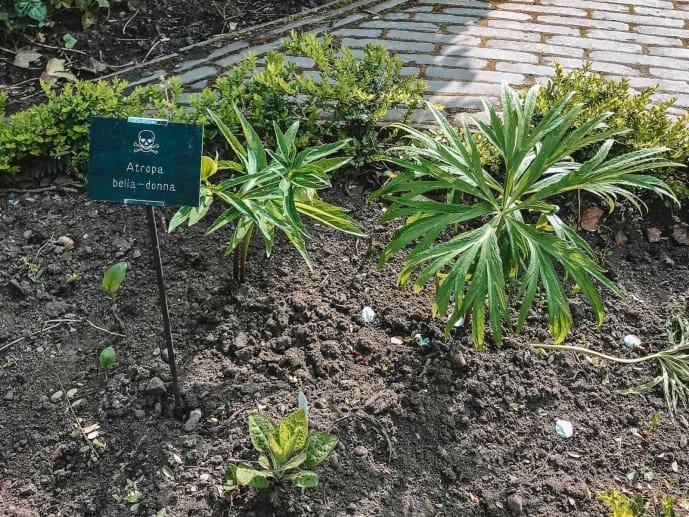
3. …and every single one of them has the ability to kill you
It may be pretty daunting but everything inside the garden has the ability to kill you in some way or another.
Whether you smell them, get too close, ingest them or touch them. It has the potential to be fatal.
Some of the plants can even affect you from a few metres away just by smelling them like Hyoscyamus niger, or stinking nightshade.
At least 3 people faint every week in the Alnwick Poison Garden. That's why you'll find their bench inside and there will be a First Aid team on hand!
You'll find that most plants have different levels of toxicity and effects on humans and animals.
Ricinus communis which looks extremely innocent and produces harmless castor oil can also produce the deadliest poison in the entire world; Ricin. It cannot be smelt or traced but can kill you instantly if it enters your bloodstream.
Belladonna, the witches berry or deadly nightshade, is a plant that is native to the UK. But, if you ingest enough of its blackberries it can kill you.
Apparently in ancient Venice, women would use the berries to make their pupils dilate, but due to the toxicity, they would go blind. The price you pay for beauty!
Ruta Graveolens which you can buy in a garden centre is also phototoxic. If you touch it and put your hands in the sunlight, it will instantly burn your skin.
The gardeners are Alnwick have to be so careful when handling the plants as it could be dangerous for their health.
They wear full suits, masks and gloves! There have been a few horror stories from fellow workers who forgot.
4. You're strictly not allowed to touch, smell or taste the poisonous plants
It may seem fairly obvious but there are some strict rules that will be laid out to you by your guide before you enter the poison garden.
You must not touch any of the plants inside, or you could potentially get deadly toxins on you or be burned by phototoxic plants.
If you get too close to any plants and smell them, their toxins could make you very sick.
The worst thing you could possibly do is eat the plants (I mean, why would you?!). This is a sure-fire way to get seriously or fatally ill.
Children must be accompanied and watched at all times!
Apparently, there have been attempts by visitors to steal some of the Atropa Belladonna that grows on the grounds. She tried and failed twice!
The guide suspected that the lady wanted it to do away with her husband… I'm not sure how much of that is true, I'm just repeating what I was told..

5. You'll learn some creepy and deadly historic stories
Just like ancient Venetian ladies used Belladonna to dilate pupils, these poisonous plants had a lot of uses in the Victorian era.
Poisons were everywhere in this time and things like laudanum and arsenic were used as medicinal and even cleaning products!
Brugmansia, or angels trumpets, was used by Victorian ladies at tea parties like a truth serum. They would take the pollen, sprinkle it in tea and hey presto, the ladies would have loose tongues!
Also, ladies of the night would use this to hallucinate their clientele. The man would think he has had an incredible night of passion but, in fact, he didn't lay a hand on her.
Laurels were also used to kill butterflies for collections. Victorians would put some crushed up laurel and the butterflies in a jar. The butterfly would eventually die from the toxic cyanide.
Mandrakes are now very popular from the Harry Potter movies. But, the whole plant is poisonous!
According to legend, as the plant root has two legs, many people would say there was a devil beneath the plant that would scream when you took it out. That's where the inspiration came from for the Potter books!
You just have to be grateful that we have the benefit of knowing these plants are deadly today. I definitely wouldn't want to go to a Brugmansia tea party that's for sure.
6. You'll be entering the minds of famous murderers
The amazing thing about these poisonous plants is that they are only poisonous when there is human intervention.
You have to do something with it in order for the poison to be extracted. There have been countless murder cases over time involving poisons extracted through deadly plants.
A famous case of a Ricin killing was with Georgi Markov, a Bulgarian dissident writer during the Cold War. He was assassinated with a dart laced with Ricin that was fired from an umbrella in London!
Lakhvinder Cheema, nicknamed the 'Curry Killer', planted Aconitum Ferox in her lover's dinner after he had threatened to leave her.
Harold Shipman, who was a trusted doctor, poisoned his patients with lethal doses of opioids!
He is now known as the most prolific serial killer in history.

7. You may be afraid to go near these pretty but deadly plants ever again!
My tour of the Alnwick Poison Garden truly fascinated me but also shocked me and made me feel super uneasy.
I'm not sure if it's due to the fact that when someone says you may faint, you feel like you're going too. But, when I was walking around I definitely felt weird due to something. Maybe it was being surrounded by so much potential death!
Most people will buy some of these plants in garden centres, grow them in their back garden or even encounter these in public parks.
It's definitely an eye-opener as to how harmful these have the ability to be.
Although some may question why such a potentially evil garden even exists, I think it can be used as a force for good. Many children visit the poison gardens for educational visits on deadly plants but also drugs.
Alnwick is legally allowed to grow cannabis which they keep caged up.
Personally, I didn't know half of the plants in here and their side effects and it definitely made me warier of what plants I approach from now on.

Other things to see in The Alnwick Garden
As soon as you're through the ivy tunnel and the exit gate on your tour, that's where the deadly plants end!
So, don't fret, there are no other dangerous plants on the whole 14 acres of these contemporary gardens.
However, there is so much to do around here you'll be spoiled for choice.
The first thing you'll notice, as soon as you walk in, is The Grand Cascade. This is made up of 120 water jets that dance and make waves throughout the day!
Nearby you can also experience the Bamboo Labyrinth where you can get lost in an endless maze of curved tunnels.
The Serpent Gardens also sparks your imagination with their creative topiary.

The Walled Rose Gardens are a delight when in season and you can find all sorts of blooms that grow around here.
There are also some awesome photo opportunities with their Giant's Mug. Don't forget to find him relaxing in the pond!
A highlight for me was their magicalCherry Blossom Festival. The Alnwick Garden has the largest collection of Taihaku trees in the world. If you visit around this time, it's heavenly and almost snowing blossom! They even have a live webcam which you can visit virtually here.
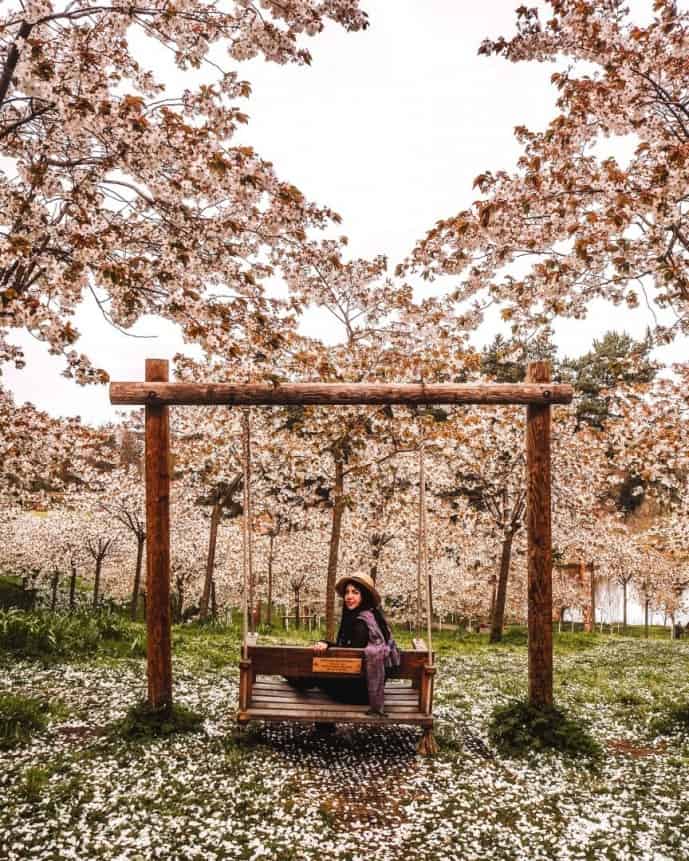
Dine in The Treehouse Restaurant
One of the best places eat at The Alnwick Garden is the Treehouse. This place is like something out of a fairytale and is one of the world's largest treehouses!
Located high in the treetops of Alnwick Forest, you'll walk over canopies to get inside.
Then you can choose a delightful meal from the menu while you're surrounded by tree branches and fairy lights.
The dishes that have been specially prepared organic produce from the gardens themselves and local farms.
A big tip I would have is to book WELL in advance. This place books up quick for lunch and dinner, so make sure you enquire a few weeks before you plan to dine.
Click here to read my full treehouse restaurant review
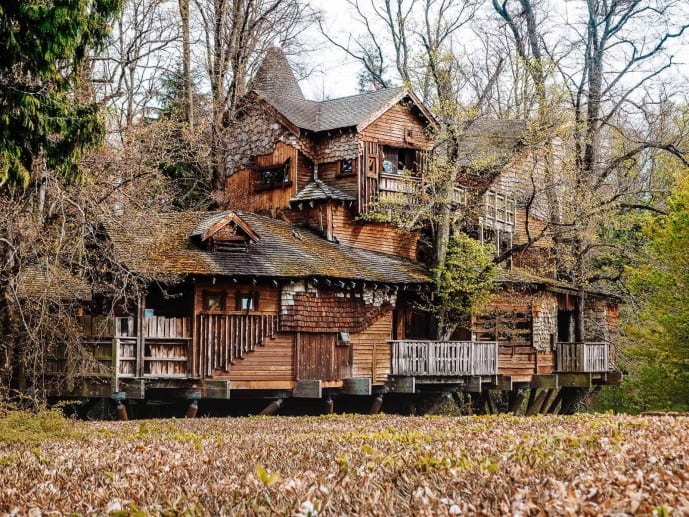
Find magic at Alnwick Castle
Potterheads will lose it at Alnwick Castle. It will transport you straight back to the Harry Potter movies. Why? Because they used this very castle as Hogwarts!
The first two movies had some of the scenes shot here including broomstick flying lessons, quidditch, the famous Levi-O-sa scene and even poor Neville losing control of his broom.
You can find all of these locations self-guided or go on a FREE Alnwick Castle film tour that's included in your entry ticket.
Don't forget to attend one of their world-famous broomstick flying lessons. Your wizarding professors with have you zooming around the courtyard in no time!
Click here to find all Harry Potter experiences at the castle
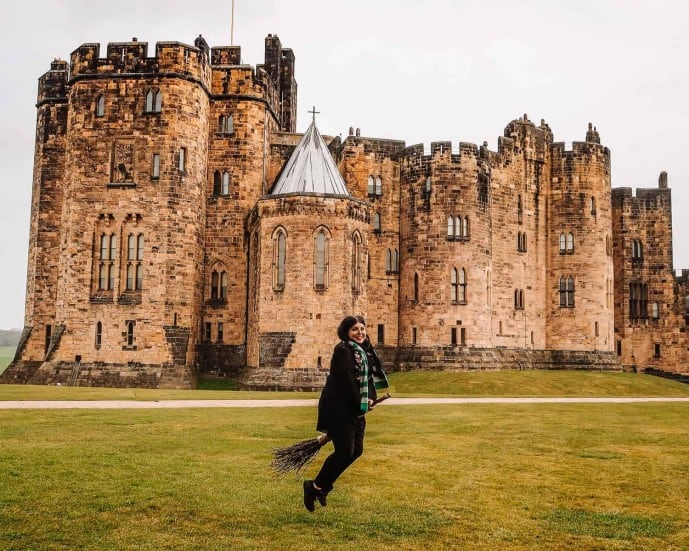
The Alnwick Poison Garden opening times
Alnwick Garden is open from 10am throughout the year but has different closing times for different seasons.
- February – March: 10am – 4pm
- March – October: 10am – 6pm
- October – December: 10am – 4pm (6pm on weekends)
The Alnwick Poison Garden is open for guided tours during these times and in high season they run every 15-30 minutes.
Is The Alnwick Garden dog friendly? Unfortunately, only assistant dogs are permitted in the gardens. But, there are many dog-friendly walks around the area!

How much are tickets for the Alnwick Garden?
Tickets for The Alnwick Garden also vary on different seasons. In winter tickets cost £13.20 an adult and £4.95 a child.
Concessions are £11.55 all prices include gift aid. In summer, tickets are £14.30 and £5.50 a child. Concessions are £12.65. All proceeds help the charity.
Alnwick Castle is not included in your ticket price. It's an attraction in its own right and if you wanted to visit it will be a separate ticket.
It definitely makes more economical sense to buy a joint ticket for both Alnwick Castle and the gardens. Combo tickets are £30.20 Adult and £13.25 a child. Concessions are £26.00.

Where is the Alnwick Poison Garden & how to get there
The Alnwick Garden is located in Alnwick in Northumberland, UK. It can easily be accessed less than a mile off the A1 motorway.
Once you take the slipway, it's really well signposted and you'll arrive on Denwick Lane on the B1340 road. Plugin NE66 1YU into your SatNav.
Parking will cost £3 for an all-day spot that is payable in Cash only.
If you plan on arriving on public transport, you get an added benefit of 20% off your garden ticket when you show proof. So, remember to present your bus or train tickets when at the ticket desk.
Alnwick Castle by train: the nearest railway station is Alnmouth. From here you can take a bus or taxi to the castle.
Alnwick Castle by bus: There are plenty of bus services that connect with Alnwick bus station, some front the city of Newcastle. It will be a five-minute walk to the castle from the main bus station.
Where to stay near the Alnwick Gardens
The Hogs Head Inn – An award winner in the North East England Tourism Awards, this place was named after the Harry Potter tavern! I love the Inn Collection Group and their properties are always cosy, with a hearty breakfast and friendly service. This Inn has 53 en-suite rooms for rent with a pub and restaurant onsite. Click here for rates.
The Cookie Jar – This boutique accommodation is an award-winning cosy retreat located right in the heart of Alnwick. The bedrooms are all unique and the amazing interiors are just to die for! There's a terrace and Bistro onsite. Click here to book.
The Bondgate Boutique – Another boutique property in a Grade II listed building dating back to the 1700s. But, you'll find cosy modern furnishings in their beautiful rooms. Click to enquire.
Read more of my Northumberland inspired articles!
Why you need to discover Ford and Etal in Northumberland
Where and when to spot Puffins in Northumberland
The prettiest castle in Northumberland
All the things to see on the Holy tidal Island of Lindisfarne
Why you must try Lindisfarne Mead!
A Last Kingdom Fans guide to Bebbanburg or Bamburgh in Northumberland!

Like it? Pin it!

What Plant Is At The Center Of The Poison Garden
Source: https://thirdeyetraveller.com/alnwick-poison-garden-england/
Posted by: petersonagaisaink1965.blogspot.com

0 Response to "What Plant Is At The Center Of The Poison Garden"
Post a Comment